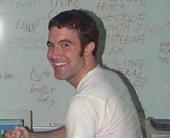The man behind MySpace


There has been a great deal of talk lately about Web 2.0. Although this primarily refers a shift toward using the Internet for applications rather than mere data retrieval, MySpace and other social networking sites like it are also
MySpace was not the first social networking site, but is by far the most successful. Counting 51.4 million users in May of this year and growing by millions of users a month, Tom Anderson has obviously hit on a winning formula for generating interest in his site. It's a happy day at my school when the content filters go down and students can check their MySpace, adding new messages, pictures, favorite songs, blog posts, etc. During graduation exercises this year, one senior asked, "Remember when everyone didn't have a MySpace?"
So what has Anderson done that others before him have not? Why has MySpace become the online destination for the ipod generation? According to BusinessWeek online,
Why has MySpace succeeded where others have generated buzz but then failed? The answer is, partly, a matter of geography. It emerged from the L.A. music and club scene, drawing on [Tom] Anderson and [MySpace CEO, Chris] DeWolfe's friends for early support. It wasn't concocted by Silicon Valley tech types or New York bankers. It was born in a city that's geared toward media and entertainment, not technology or finance. And like other great exports from Southern California -- such as Hollywood and surfboards -- MySpace tapped into the country's psyche.
That's right, Tom Anderson, age 30, started MySpace so that his band and others emerging on the LA music scene would have a place to share and promote their music. With business leadership from MySpace CEO Chris DeWolfe and a real understanding of the music industry based on personal experience and education (degrees from the University of California in Rhetoric, English, and Film), Tom Anderson has gone as far now as to create a MySpace record label. With built-in capabilities to share music, MySpace has become a magnet for bands and the young people who can't load enough new music onto their ipods. Indeed, MySpace may represent the best way for bands to make money in an era of free downloads and widespread piracy. Again, according to BusinessWeek online,
Bands can create home pages, with photos, tour dates, and as many as four songs -- all for free. Marquee names like the Black-Eyed Peas, My Chemical Romance, and ex-Smashing Pumpkins leader Billy Corgan joined. That pulled in fans and their friends, who all found that MySpace offered loads of options that other sites lacked. Now, MySpace has become something akin to the hottest bar in town, teeming with musicians and models.
Whereas bands now readily use MySpace to stay in touch with fans and promote shows, release new music, etc., an increasing number of business recruiters troll MySpace to find new talent. What better way to measure someone's marketability in the Digital Age than to check out their MySpace? Perhaps more importantly, what better way to ensure that new prospects don't spend their weekends partying and their weeks posting bad cell phone pictures of their exploits?
According to Anderson in an interview with Forbes, this is the real secret of MySpace' success:
On Friendster, if you were a band and you made a profile, they would delete it. They didn’t want bands on their site. If you made a profile for your company or for where you lived or a neighborhood or an idea, you’d get deleted. We recognized from the beginning that we could create profiles for the bands and allow people to use the site any way they wanted to. We didn’t stop people from promoting whatever they wanted to promote on MySpace. Some people have fun with it, and others try to get more business and sell stuff, like a makeup artist or a band, and we encourage them to do that.
The explosive growth of MySpace has not been free of problems. Most of us have read the headlines about sexual predators and child safety on MySpace. However, Tom Anderson and his small company have changed the way young people communicate, promote themselves, and promote their causes. In its short life, Tom Anderson has never let MySpace stray from its vision of providing a highly customizable and user-friendly online alternative to a traditional web site. He, and those who follow after him, are the players to watch on the social side of Web 2.0.
Our IT Shapers:
- Richard Stallman: The most hated man in cyberspace
- Barrett Lyon: Internet Influencer
- Dan'l Lewin: Leading Microsoft Emerging Business Development
- Kevin Lynch: Making the Rich Internet Application a reality
- George Boole: On the shoulders of genius
- Howard Rheingold about our mobile world
- Tom Anderson: The man behind MySpace
- Users always have the final say